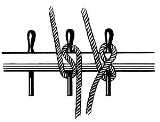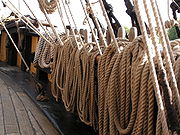
Belaying pin
Encyclopedia
.jpg)
Rigging
Rigging is the apparatus through which the force of the wind is used to propel sailboats and sailing ships forward. This includes masts, yards, sails, and cordage.-Terms and classifications:...
. Their function on modern vessels has been replaced by cleats
Cleat (nautical)
In nautical contexts, a cleat is a device for securing a rope. The traditional design is attached to a flat surface or a spar and features two “horns” extending parallel to the deck or the axis of the spar, resembling an anvil....
, but they are still used, particularly on square rig
Square rig
Square rig is a generic type of sail and rigging arrangement in which the primary driving sails are carried on horizontal spars which are perpendicular, or square, to the keel of the vessel and to the masts. These spars are called yards and their tips, beyond the last stay, are called the yardarms...
ged ships.
A belaying pin is a solid metal or wooden bar with a curved top portion and cylindrical bottom part. It is inserted into a hole in a wooden pinrail, which usually runs along the inside of the bulwark
Bulwark
Bulwark may refer to:*A bastion or fortifications in general*In naval terminology, an extension of a ship's sides above deck level*HMS Bulwark, any of several Royal Navy ships*USS Bulwark, any of several US Navy ships...
s as shown (although free-standing pinrails called fife rails
Fife rail
A fife rail is a design element of the bulwarks of a European-style sailing ship used to belay the ship's halyards at the base of a mast. When surrounding a mast, a fife rail is sometimes referred to specifically by the name of the mast with which it is associated: the main fife rail surrounds the...
are also used). Although the belaying pin can be lifted out and removed, it is usually left in place.
To secure a line, it is first led around the bottom of the pin and then the top, to form a complete turn. It is taken once more around the bottom of the pin, and then three cross-shaped turns are applied by looping the line round alternate sides of the top and bottom. This pattern can be remembered as "one hug and three kisses". Other arrangements are possible, but ensuring that the same pattern is used on a particular ship means that sailors know what to expect when releasing a line fastened by someone else - possibly in the dark.

Making fast under load
Lines are normally made fast to belaying pins after being hauled on by a team of sailors. It is important that as little line as possible be let out in the process of securing it to the pin. When the line to be hauled on descends vertically to the pin (like the clewlines and buntlinesClewlines and buntlines
For the revolver, see Colt BuntlineClewlines and buntlines are lines used to handle the sails of a square rigged ship.Although the common perception of a traditionally rigged ship is that the sails are handled from "up in the rigging", the majority of the work is actually carried out from the deck...
in the top picture) half the first turn can be left in place, so that the line comes down, round the back of the bottom of the pin, and then out across the deck. Simply hauling on the end of the line, though, will be very inefficient because of the friction produced by the half-turn on the pin. Instead the team is divided into "sweaters" pulling on the vertical part and "tailers" on the horizontal section - usually with more sweaters than tailers. When the line is to be secured, the half turn enables the tension to be held until it is properly made fast.
Some other lines run horizontally past their pins, and it is harder to maintain the tension between stopping hauling and making fast. Generally the line is held against the pin and the rail by hand - which helps a little but not much - and the transition between hauling and securing is then made as quickly as possible. At a shout of "come up!" the hauling team instantly provide the front man with slack line, and he snaps on the first turn. Inevitably some line will be lost in this procedure.
Finally, lines under very heavy load such as topsail halyards are equipped with short stopper lines attached near their pins. These are wound round the hauling line and held, to prevent it moving once the team stop hauling to allow it to be made fast.
Lines under tension can be let out in a controlled manner by leaving the first turn on the pin to provide friction. However, the hands must be kept a safe distance back along the rope or they may be dragged around the pin too.
Other uses
- Belaying pins were apparently commonly used as improvised weapons (as well as a method of discipline) on both military and civilian ships. Certainly their shape and weight would make a formidable short-range club.
- Belaying pin splice (specialty method of performing emergency rejoining of ship's rigging), where a belaying pin, marlinspikeMarlinspikeMarlinspike is a tool used in ropework for tasks such as unlaying rope for splicing, untying knots, forming a toggle , or forming a makeshift handle....
, or other short bar of strong material is used to hold two eye-loops of rope together.
- A belaying pin can also be tied to the end of a line being thrown, the extra weight helping it carry further. This is also an improvised use - the proper tool for the job is a monkey's fistMonkey's fistA monkey's fist or monkey paw is a type of knot, so named because it looks somewhat like a small bunched fist/paw. It is tied at the end of a rope to serve as a weight, making it easier to throw, and also as an ornamental knot. This type of weighted rope can be used as an improvised weapon,...
- a lump of woven rope forming a small but heavy ball with a loop for attaching the end of a line.

